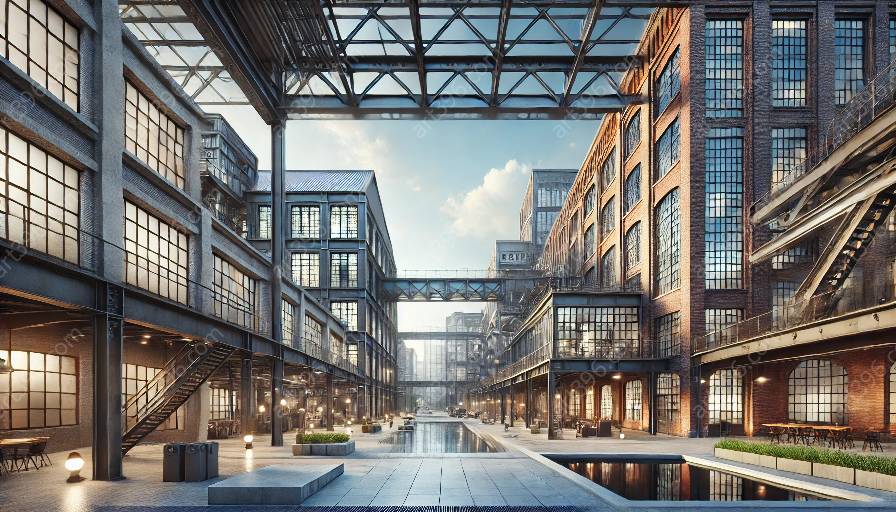Industrial architecture encompasses the design and construction of buildings and structures specifically for industrial purposes. These buildings are often characterized by large open spaces, exposed structural elements, and an emphasis on functionality. In recent years, there has been a growing trend towards adaptive reuse of old industrial buildings – repurposing these structures for new and creative uses while preserving their historical and architectural significance.
The Principles of Adaptive Reuse in Industrial Architecture:
1. Preserve Historical Significance
When considering an adaptive reuse project in industrial architecture, it is essential to prioritize the preservation of the building's historical significance. This involves understanding the building's original purpose, architectural style, and cultural context. By integrating the building's history into the new design, architects can create a sense of continuity and appreciation for the past.
2. Sustainable Transformation
Adaptive reuse in industrial architecture offers an opportunity to contribute to sustainable development by repurposing existing structures rather than building new ones. This sustainable approach reduces the impact on the environment, minimizes waste, and conserves resources. Architects must consider concepts such as energy efficiency, material reclamation, and adaptive building systems to ensure a sustainable transformation.
3. Flexibility and Functionality
Old industrial buildings often have large open floor plans and robust structural systems, presenting opportunities for flexible and functional design solutions. Adaptive reuse projects in industrial architecture should prioritize adaptability to accommodate various uses and activities. This may involve integrating modern amenities, infrastructure, and technologies while respecting the building's original industrial character.
4. Design Innovation
Adaptive reuse projects provide architects with a platform for design innovation and creativity. The juxtaposition of old industrial elements with contemporary design features can result in unique and visually compelling spaces. Balancing the preservation of historical elements with modern design interventions requires a sensitive and thoughtful approach to architectural design.
5. Community Engagement
Successful adaptive reuse projects in industrial architecture often involve community engagement and stakeholder collaboration. Understanding the needs and aspirations of the local community is crucial in repurposing industrial buildings to serve new functions. Engaging with local residents, businesses, and organizations can enrich the design process and ensure that the adaptive reuse project contributes positively to the community.
6. Regulatory Considerations
Adaptive reuse projects in industrial architecture may encounter regulatory challenges related to zoning, building codes, and historic preservation requirements. Architects and design professionals must navigate these regulatory considerations to ensure compliance while seeking opportunities for creative interpretation and adaptive design solutions. Collaboration with regulatory authorities and preservation groups is essential for the successful realization of adaptive reuse projects.
7. Contextual Integration
Integrating the adaptive reuse project within its surrounding urban or industrial context is a critical consideration. The design should respond to the site's historical, environmental, and social context, enriching the fabric of the existing urban or industrial landscape. Architectural interventions should be harmonious with the existing context while contributing to the revitalization and activation of the surrounding area.
8. Preservation of Structural Integrity
Preserving the structural integrity of old industrial buildings is fundamental to the success of adaptive reuse projects. Architects and engineers need to assess the existing structural systems, identify areas for reinforcement or restoration, and ensure that the building can safely accommodate its new intended use. This may involve innovative structural solutions to retain the building's original character while meeting contemporary safety standards.
9. Celebrating Authenticity
Adaptive reuse projects offer an opportunity to celebrate the authenticity of industrial architecture. Embracing the raw materials, exposed structures, and patina of age can create an aesthetic that honors the building's industrial heritage. Integrating original features, such as industrial machinery or signage, into the new design can evoke a sense of nostalgia and authenticity.
10. Educational and Cultural Value
Old industrial buildings often possess educational and cultural value, serving as tangible links to the industrial history of a region. Adaptive reuse projects should leverage this value by creating opportunities for public engagement, educational programs, and cultural events within the repurposed space. By sharing the building's history and significance, the adaptive reuse project can become a catalyst for cultural enrichment and community storytelling.
The Intersection of Adaptive Reuse and Sustainable Design in Industrial Architecture
Adaptive reuse in industrial architecture exemplifies the intersection of preservation, sustainability, and design innovation. By applying the principles outlined above, architects and designers can transform old industrial buildings into vibrant, sustainable, and culturally significant spaces that contribute to the fabric of the built environment. The marriage of historical preservation with contemporary functionality and sustainability reflects a forward-thinking approach to architectural practice, one that cherishes the past while embracing the future.





























































